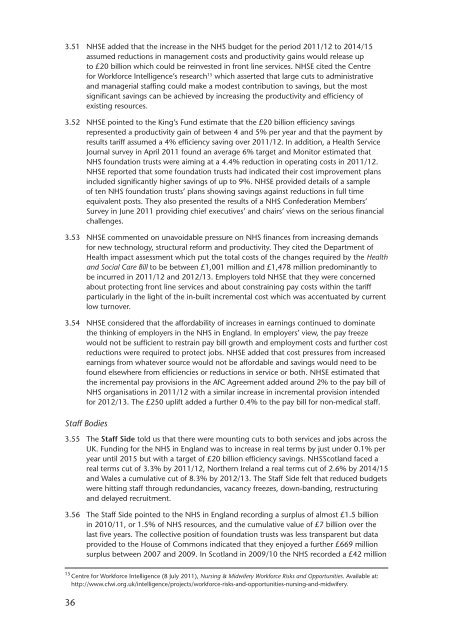NHS pay review body: twenty-sixth report 2012 - Official Documents
NHS pay review body: twenty-sixth report 2012 - Official Documents
NHS pay review body: twenty-sixth report 2012 - Official Documents
You also want an ePaper? Increase the reach of your titles
YUMPU automatically turns print PDFs into web optimized ePapers that Google loves.
3.51 <strong>NHS</strong>E added that the increase in the <strong>NHS</strong> budget for the period 2011/12 to 2014/15<br />
assumed reductions in management costs and productivity gains would release up<br />
to £20 billion which could be reinvested in front line services. <strong>NHS</strong>E cited the Centre<br />
for Workforce Intelligence’s research15 which asserted that large cuts to administrative<br />
and managerial staffing could make a modest contribution to savings, but the most<br />
significant savings can be achieved by increasing the productivity and efficiency of<br />
existing resources.<br />
3.52 <strong>NHS</strong>E pointed to the King’s Fund estimate that the £20 billion efficiency savings<br />
represented a productivity gain of between 4 and 5% per year and that the <strong>pay</strong>ment by<br />
results tariff assumed a 4% efficiency saving over 2011/12. In addition, a Health Service<br />
Journal survey in April 2011 found an average 6% target and Monitor estimated that<br />
<strong>NHS</strong> foundation trusts were aiming at a 4.4% reduction in operating costs in 2011/12.<br />
<strong>NHS</strong>E <strong>report</strong>ed that some foundation trusts had indicated their cost improvement plans<br />
included significantly higher savings of up to 9%. <strong>NHS</strong>E provided details of a sample<br />
of ten <strong>NHS</strong> foundation trusts’ plans showing savings against reductions in full time<br />
equivalent posts. They also presented the results of a <strong>NHS</strong> Confederation Members’<br />
Survey in June 2011 providing chief executives’ and chairs’ views on the serious financial<br />
challenges.<br />
3.53 <strong>NHS</strong>E commented on unavoidable pressure on <strong>NHS</strong> finances from increasing demands<br />
for new technology, structural reform and productivity. They cited the Department of<br />
Health impact assessment which put the total costs of the changes required by the Health<br />
and Social Care Bill to be between £1,001 million and £1,478 million predominantly to<br />
be incurred in 2011/12 and <strong>2012</strong>/13. Employers told <strong>NHS</strong>E that they were concerned<br />
about protecting front line services and about constraining <strong>pay</strong> costs within the tariff<br />
particularly in the light of the in-built incremental cost which was accentuated by current<br />
low turnover.<br />
3.54 <strong>NHS</strong>E considered that the affordability of increases in earnings continued to dominate<br />
the thinking of employers in the <strong>NHS</strong> in England. In employers’ view, the <strong>pay</strong> freeze<br />
would not be sufficient to restrain <strong>pay</strong> bill growth and employment costs and further cost<br />
reductions were required to protect jobs. <strong>NHS</strong>E added that cost pressures from increased<br />
earnings from whatever source would not be affordable and savings would need to be<br />
found elsewhere from efficiencies or reductions in service or both. <strong>NHS</strong>E estimated that<br />
the incremental <strong>pay</strong> provisions in the AfC Agreement added around 2% to the <strong>pay</strong> bill of<br />
<strong>NHS</strong> organisations in 2011/12 with a similar increase in incremental provision intended<br />
for <strong>2012</strong>/13. The £250 uplift added a further 0.4% to the <strong>pay</strong> bill for non-medical staff.<br />
Staff Bodies<br />
3.55 The Staff Side told us that there were mounting cuts to both services and jobs across the<br />
UK. Funding for the <strong>NHS</strong> in England was to increase in real terms by just under 0.1% per<br />
year until 2015 but with a target of £20 billion efficiency savings. <strong>NHS</strong>Scotland faced a<br />
real terms cut of 3.3% by 2011/12, Northern Ireland a real terms cut of 2.6% by 2014/15<br />
and Wales a cumulative cut of 8.3% by <strong>2012</strong>/13. The Staff Side felt that reduced budgets<br />
were hitting staff through redundancies, vacancy freezes, down-banding, restructuring<br />
and delayed recruitment.<br />
3.56 The Staff Side pointed to the <strong>NHS</strong> in England recording a surplus of almost £1.5 billion<br />
in 2010/11, or 1.5% of <strong>NHS</strong> resources, and the cumulative value of £7 billion over the<br />
last five years. The collective position of foundation trusts was less transparent but data<br />
provided to the House of Commons indicated that they enjoyed a further £669 million<br />
surplus between 2007 and 2009. In Scotland in 2009/10 the <strong>NHS</strong> recorded a £42 million<br />
15 Centre for Workforce Intelligence (8 July 2011), Nursing & Midwifery Workforce Risks and Opportunities. Available at:<br />
http://www.cfwi.org.uk/intelligence/projects/workforce-risks-and-opportunities-nursing-and-midwifery.<br />
36
















